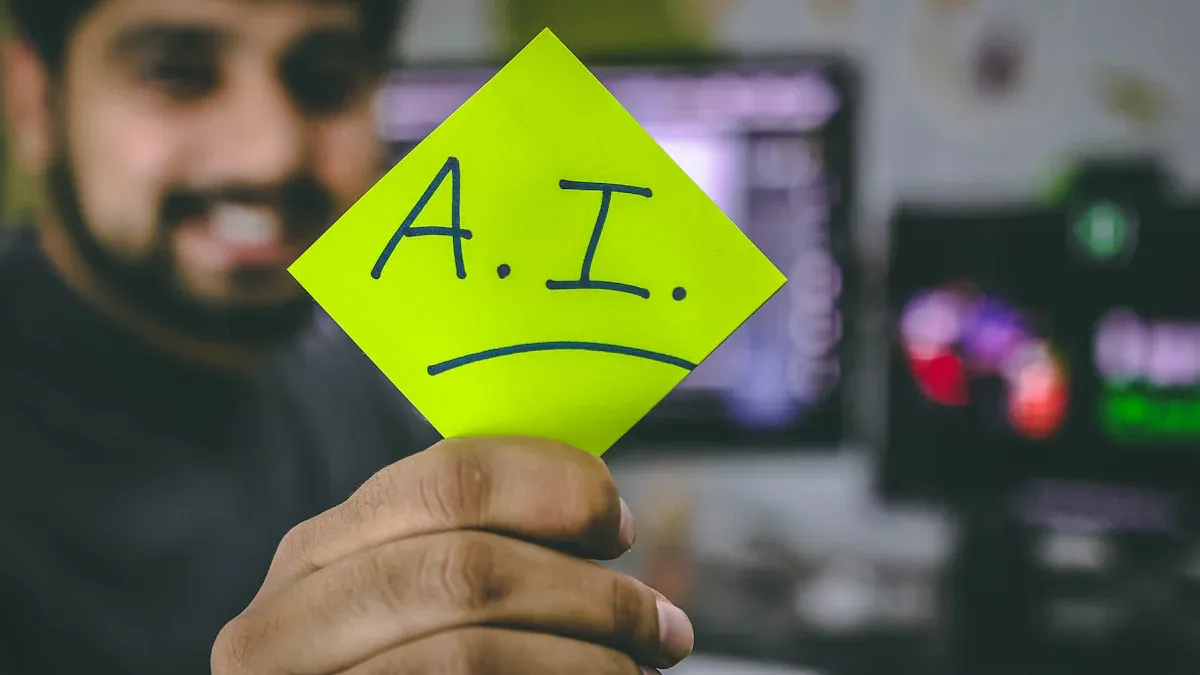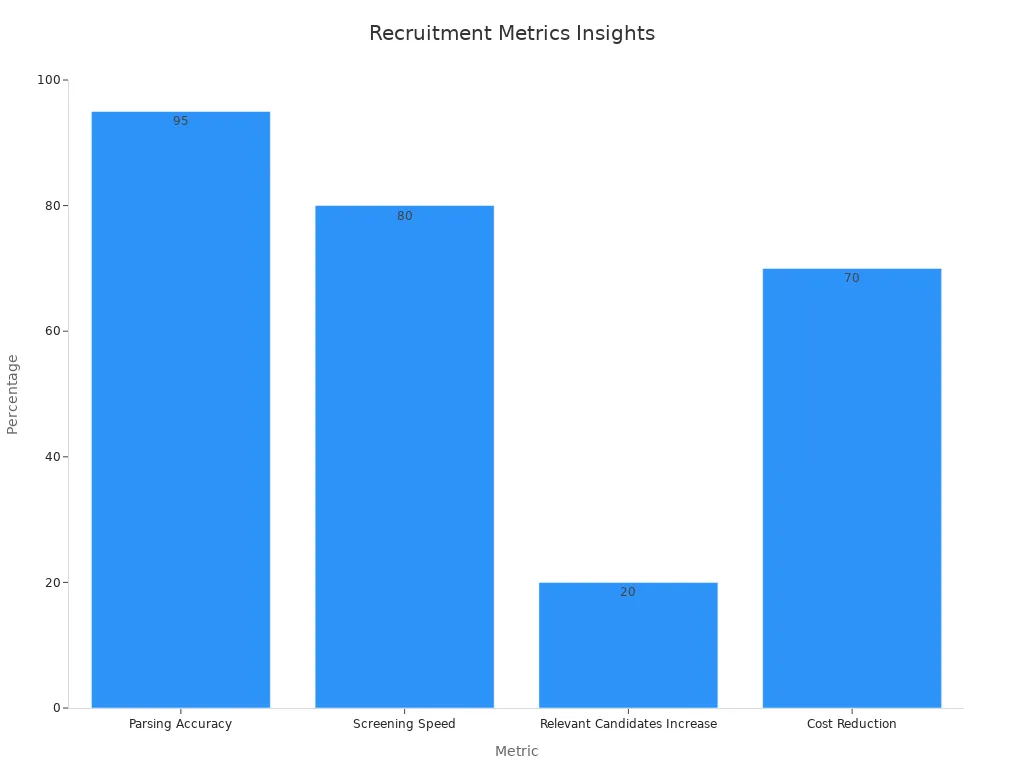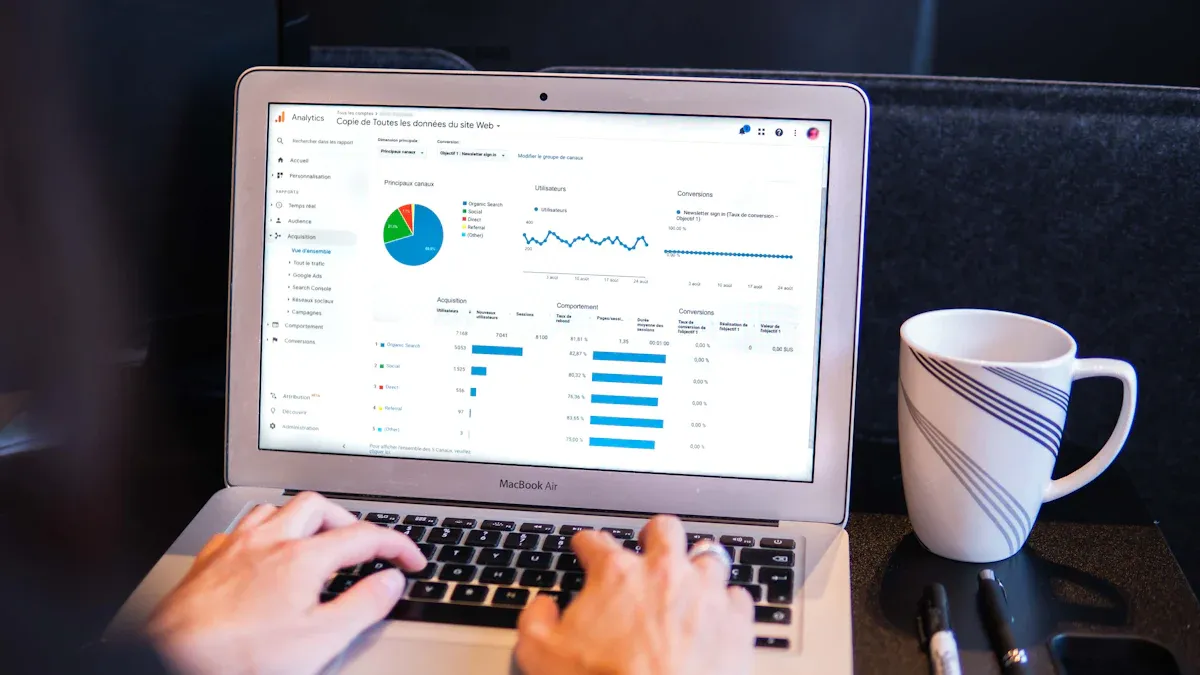How AI Improves Resume Screening Efficiency in Recruitment

AI has transformed the way you screen resumes, making the process faster and more accurate. Traditional methods often involve hours of manual work, but AI tools can analyze hundreds of applications in minutes. These tools reduce human errors and ensure fairer evaluations by focusing on skills and qualifications. By measuring the efficiency of AI-powered resume screening, you can see how it improves candidate matching and saves valuable time. This technology allows you to focus on connecting with top talent instead of sifting through piles of resumes.
Key Takeaways
AI makes resume screening faster, checking hundreds in minutes instead of hours.
It lowers human mistakes and unfair judgments, focusing on skills and qualifications.
Adding AI to tracking systems makes hiring quicker and finds better candidates.
Teaching HR teams to use AI tools helps them work better and hire fairly.
Checking and improving AI systems often keeps them accurate and fair for hiring.
Limitations of Traditional Resume Screening
Time-consuming manual processes
Manually screening resumes takes a significant amount of time. Recruiters often spend 6-8 seconds on an initial review of each resume. For a job posting with 500 applications, this adds up to 4-5 hours just for the first round. A more detailed review can take 2-3 minutes per resume, resulting in over 16 hours for a single role. If your company is hiring for multiple positions, the time investment can exceed 160 hours per month. This process delays hiring decisions and reduces the time you can spend on other critical recruitment tasks.
Inconsistencies in human decision-making
Human decision-making during resume screening often lacks consistency. Factors like résumé length, personal interests, or volunteering experience can influence evaluations differently depending on the recruiter. For example, one recruiter might prioritize volunteering experience, while another might overlook it entirely. These inconsistencies can lead to unfair evaluations and missed opportunities to identify the best candidates. Additionally, limited attention spans can result in superficial assessments, causing you to overlook highly qualified applicants.
Component | Impact on Decision-Making |
|---|---|
Résumé Length | Varies |
Personal Interests | Varies |
Volunteering | Varies |
Risk of unconscious bias in candidate selection
Unconscious bias is a significant challenge in traditional resume screening. Biases related to gender, race, age, or ethnicity can influence hiring decisions without you even realizing it. For instance, candidates with names perceived as foreign may face discrimination. Similarly, subtle language cues in resumes can lead to gender-based preferences. These biases not only harm workplace diversity but also affect employee morale and innovation. Addressing unconscious bias is essential to ensure fair and effective hiring practices.
Tip: Proactively identifying and correcting unconscious bias can improve your hiring outcomes and foster a more inclusive workplace.
Challenges in managing high application volumes
Handling a large number of applications can overwhelm even the most experienced recruiters. When hundreds or even thousands of resumes flood in for a single job posting, managing them manually becomes nearly impossible. You may find it difficult to dedicate enough time to each application, which increases the risk of overlooking qualified candidates.
Recruiters often spend about 7.5 seconds reviewing a single resume. With high application volumes, this adds up quickly, leaving little room for thorough evaluations. Employers typically make only one quality hire from every 46 applications submitted through job boards. This low success rate highlights how challenging it is to identify top talent in a sea of resumes.
Ranking applicants and assessing their skills also becomes a significant hurdle. Nearly 43% of employers struggle to determine a candidate’s qualifications based solely on their resume. This issue becomes even more pronounced when only 12% of candidates meet job requirements after screening calls. These inefficiencies can delay the hiring process and frustrate both recruiters and applicants.
Traditional methods also fail to address the time constraints recruiters face. Screening resumes, scheduling interviews, and conducting follow-ups require hours of effort. When you’re managing multiple job openings, the workload can quickly spiral out of control.
Tip: Streamlining your process with technology can help you manage high application volumes more effectively. By automating repetitive tasks, you can focus on engaging with the most promising candidates and making better hiring decisions.
High application volumes demand a more efficient approach. Without the right tools, you risk missing out on top talent and wasting valuable time on unqualified candidates.
How AI-Powered Tools Work in Resume Screening

Keyword matching and parsing resumes
AI-powered tools excel at identifying relevant keywords in resumes, ensuring that applications align with job descriptions. These tools parse resumes with remarkable accuracy, extracting critical information like skills, education, and work experience. By automating this process, you can save time and focus on evaluating top candidates.
For example, AI systems achieve a 95% parsing accuracy and screen resumes 80% faster than traditional methods. This efficiency leads to a 20% increase in relevant candidates while reducing recruitment costs by up to 70%.
Metric | Value |
|---|---|
Parsing Accuracy | 95% |
Screening Speed | 80% Faster |
Relevant Candidates Increase | 20% More Relevant |
Cost Reduction | Up to 70% |

Automated ranking and scoring of candidates
AI tools streamline candidate evaluation by ranking and scoring resumes based on predefined criteria. These systems analyze qualifications, skills, and experience to generate a shortlist of the most suitable applicants. This automation reduces the risk of overlooking qualified candidates and ensures a more objective selection process.
For instance, platforms like the Odyssey Digital Automation Platform use AI to evaluate resumes, significantly improving hiring efficiency. A study by the Harvard Business Review found that companies using AI in recruitment are 46% more likely to make successful hires. Machine learning algorithms also enhance accuracy by quickly analyzing large volumes of applications, saving you valuable time.
Skill and experience assessment using AI algorithms
AI algorithms assess candidates' skills and experience by comparing their resumes to job requirements. Unlike traditional methods, which rely on manual reviews, AI tools focus on capabilities rather than credentials. This approach minimizes bias and ensures fair evaluations.
AI resume builders, for example, tailor resumes to job descriptions by analyzing postings and suggesting relevant skills. These tools provide real-time feedback, helping candidates improve their applications. They also save recruiters up to 75% of the time spent on evaluations.
Evidence Type | Description |
|---|---|
Skill Assessment | AI-driven assessments measure candidates' actual skills against job requirements, enhancing the hiring process by focusing on capabilities rather than credentials. |
Bias Reduction | AI assessments minimize bias in hiring by evaluating candidates based on performance rather than personal details. |
Efficiency | AI tools streamline the hiring process, reducing time-to-hire and costs associated with bad hires. |
By leveraging AI for skill and experience assessment, you can identify top talent more effectively and create a fairer hiring process.
Integration with applicant tracking systems (ATS)
Integrating AI-powered tools with applicant tracking systems (ATS) can revolutionize your recruitment process. ATS platforms already help you manage applications, but combining them with AI takes efficiency to the next level. AI enhances the capabilities of ATS by automating resume screening, ranking candidates, and identifying top talent faster.
AI-powered tools work seamlessly with ATS to reduce time-to-hire by up to 50%. This integration allows you to process applications more quickly, ensuring you don’t lose top candidates to competitors. By automating repetitive tasks, you can focus on engaging with qualified applicants and making better hiring decisions.
Here are some key benefits of integrating AI with ATS:
Improved candidate quality: Companies report a 70% improvement in the quality of candidates when using AI in recruitment.
Enhanced diversity: Unilever’s AI-based recruitment solution increased hiring diversity by 16%, demonstrating how AI can reduce bias.
Streamlined processes: AI tools analyze resumes, rank candidates, and provide actionable insights, saving you time and effort.
Unilever’s success story highlights the practical advantages of this integration. Their AI solution included video interviews analyzed by algorithms, which reduced bias and improved diversity. This example shows how AI can create a fairer and more inclusive hiring process.
By integrating AI with your ATS, you can transform how you manage applications. The combination of these technologies ensures faster, more accurate, and unbiased hiring decisions. This approach not only saves time but also helps you attract and retain top talent in a competitive job market.
Measuring the Efficiency of AI-Powered Resume Screening
Speed and accuracy in processing applications
AI-powered resume screening significantly improves the speed and accuracy of processing applications. Traditional methods often require hours to manually review resumes, but AI tools can evaluate hundreds of applications in just minutes. For every 100 resumes, manual screening takes approximately 10 hours with an accuracy rate of 70%. In contrast, AI-powered systems complete the same task in just 1 hour with an impressive 95% accuracy rate.
Method | Time Taken (per 100 resumes) | Accuracy Rate |
|---|---|---|
Manual Screening | 10 hours | 70% |
AI-Powered Screening | 1 hour | 95% |
Organizations using AI in recruitment report a 35% reduction in hiring time. Additionally, 70% of recruiters believe AI helps them hire faster. These improvements allow you to focus on engaging with top candidates rather than spending time on repetitive tasks.
Reduction of human errors in candidate evaluation
AI tools reduce human errors by providing consistent and objective evaluations. Unlike humans, AI systems do not get fatigued or influenced by unconscious biases. Studies show that AI integration improves candidate-job fit by 30% and increases predictive validity by 15%. This ensures that you select candidates based on their qualifications and skills rather than subjective factors.
Study Reference | Findings | Improvement in Human Error Reduction |
|---|---|---|
Smith et al., 2022 | 30% improvement in candidate-job fit | Enhanced accuracy in evaluations |
Doe & Lee, 2021 | 15% increase in predictive validity | Reduced human error in assessments |
Jones, 2022 | 25% increase in diversity hires | Fairness and precision in evaluations |
By minimizing errors, AI-powered resume screening enhances the overall quality of your hiring process. This leads to better hiring decisions and a more diverse workforce.
Enhanced precision in matching candidates to job requirements
AI-powered tools excel at matching candidates to job requirements with precision. These systems analyze resumes to assess skills, experience, and qualifications, ensuring alignment with job descriptions. For example, AI-enhanced evaluations provide detailed assessments of coding proficiency and problem-solving abilities. They also simulate real-world scenarios to evaluate candidates' skills effectively.
AI-powered skills mapping offers a clear view of talent within your organization. It dynamically matches candidates to roles based on their potential and provides insights into emerging skills trends. Additionally, integrated video interviews and comprehensive analytics offer a holistic evaluation of candidates, ensuring you make data-driven hiring decisions.
By leveraging AI, you can achieve a higher level of precision in identifying the best candidates for your roles. This not only improves hiring outcomes but also enhances the overall efficiency of your recruitment process.
Scalability for high-volume recruitment needs
AI-powered resume screening tools excel at handling high application volumes, making them ideal for large-scale recruitment efforts. When your organization receives thousands of applications for multiple roles, managing them manually becomes overwhelming. AI tools process these applications efficiently, ensuring no qualified candidate gets overlooked.
One of the key advantages of AI is its ability to scale without compromising accuracy. Whether you are hiring for one position or fifty, AI systems maintain consistent performance. These tools analyze resumes, rank candidates, and identify top talent in a fraction of the time it would take a human recruiter. For example, AI can screen 1,000 resumes in under an hour, a task that could take days using traditional methods.
Tip: Use AI to streamline your recruitment process during peak hiring seasons or when launching large-scale hiring campaigns.
AI also supports scalability by integrating with applicant tracking systems (ATS). This integration allows you to manage applications from multiple job boards and career sites in one place. By automating repetitive tasks, you can focus on engaging with the most promising candidates. Additionally, AI tools provide actionable insights, helping you make data-driven decisions even when dealing with high volumes of data.
Measuring the efficiency of AI-powered resume screening becomes crucial when scaling your recruitment efforts. Metrics like time-to-hire, candidate quality, and cost savings demonstrate how AI enhances scalability. By leveraging these tools, you can handle high-volume recruitment needs effectively while maintaining a high standard of candidate evaluation.
Addressing Concerns About AI in Recruitment
Ensuring transparency in AI decision-making
Transparency in AI decision-making is essential to build trust and ensure fairness in recruitment. You need to understand how AI tools evaluate candidates and make decisions. Blind hiring practices can help eliminate bias by anonymizing candidate information, allowing AI to focus solely on skills and experience. This ensures that hiring decisions are based on relevant qualifications rather than demographic factors.
Incorporating diverse hiring panels also plays a crucial role. These panels provide varied perspectives, which help mitigate biases that AI might overlook. Additionally, skills-based AI systems enhance transparency by prioritizing candidates' abilities over personal details.
Tip: Consider using third-party certifications and testing for AI tools. These measures ensure that the algorithms meet consistent standards and operate fairly. External oversight can further enhance transparency and accountability in your recruitment process.
Mitigating potential biases in AI algorithms
AI algorithms can unintentionally amplify biases present in historical data. For example, datasets often contain unstructured information, which may misrepresent underrepresented groups. This leads to a "bias in and bias out" phenomenon, perpetuating inequalities.
A 2019 study by the U.S. National Institute of Standards and Technology revealed that most facial recognition algorithms falsely identified non-white faces. Similarly, Amazon discontinued a recruiting tool in 2018 due to its bias against women. These examples highlight the importance of addressing biases in AI systems.
Statistic | Description |
|---|---|
Job recommendations based on identity rather than qualifications. | |
30% | Job alerts below current skill levels. |
63% | Academic recommendations lower than actual achievements. |
To mitigate these issues, you can use tools like Microsoft's Fairlearn and InterpretML. These platforms assess and improve fairness in AI systems. Diverse development teams also help create less biased models, ensuring a more equitable hiring process.
Balancing automation with human oversight
While AI improves efficiency, human oversight remains critical in recruitment. Automation handles repetitive tasks like resume screening and interview scheduling, saving you time. However, AI lacks empathy and struggles to assess cultural fit, which are vital aspects of hiring.
Benefits | Challenges |
|---|---|
AI cannot display empathy or understanding. | |
Data-driven insights into candidate performance. | Cultural fit assessment requires human judgment. |
Enhanced candidate experience through quick responses. | Candidates prefer human interaction during complex stages. |
Balancing automation with human involvement ensures a personal connection with candidates. You can use AI for initial screenings while reserving critical decisions for human recruiters. This approach combines the strengths of both, creating a fair and efficient hiring process.
Ethical considerations in AI-driven recruitment
AI-driven recruitment offers many benefits, but ethical concerns must guide its implementation. You need to ensure that AI tools operate fairly and transparently. Without proper oversight, these systems may unintentionally reinforce biases or make decisions that lack accountability.
One key ethical consideration is transparency. You should understand how AI evaluates candidates and makes decisions. Transparent algorithms allow you to explain hiring outcomes to candidates, building trust in the process. A study by Harvard Business Review shows that companies using transparent algorithms reduce hiring bias by up to 30%. This approach ensures that candidates feel valued and fairly assessed.
Fairness is another critical factor. AI systems often rely on historical data, which may contain biases. These biases can lead to unfair treatment of underrepresented groups. Companies like IBM address this issue by following ethical guidelines when developing AI tools. Their approach has improved hiring efficiency by 30% and increased candidate diversity by 20%. Similarly, Unilever uses AI to screen over 1.8 million applicants annually, achieving a 50% reduction in hiring bias and enhancing workforce diversity.
Continuous monitoring of AI tools is essential for ethical recruitment. Regular evaluations help you identify and correct biases, ensuring that the system evolves with your organization’s needs. Research by the World Economic Forum highlights that monitoring AI tools can improve employee satisfaction by up to 75%. This practice not only enhances fairness but also strengthens your company’s reputation.
By prioritizing transparency, fairness, and accountability, you can create an ethical AI-driven recruitment process. These principles ensure that your hiring practices remain inclusive and trustworthy, benefiting both your organization and potential candidates.
Practical Steps for Implementing AI in Recruitment

Selecting the right AI tools for your organization
Choosing the right AI tools for recruitment requires careful consideration. You need to understand the technologies available and how they align with your hiring goals. Tools that utilize natural language processing (NLP) can improve candidate matching by analyzing resumes and job descriptions. Predictive analytics can help forecast candidate success based on historical data, giving you insights into long-term hiring outcomes.
To ensure seamless operation, prioritize tools that integrate easily into your existing workflows. Ethical considerations should also guide your selection process. AI systems must avoid biases to ensure fair hiring practices.
Understand AI technologies and their applications in recruitment.
Prioritize ethical AI tools to reduce bias.
Choose systems that integrate smoothly with current workflows.
Utilize NLP for better candidate matching.
Leverage predictive analytics for forecasting candidate success.
Selecting the right tools sets the foundation for efficient and fair recruitment processes.
Training HR teams to use AI-powered systems effectively
Training your HR team is essential for maximizing the benefits of AI-powered recruitment systems. Programs that focus on AI technologies and data analytics enhance your team’s ability to interpret AI-generated insights. Upskilling HR personnel ensures they can collaborate effectively with AI tools, combining human judgment with technological precision.
Ongoing evaluations of training programs help maintain fairness and equity in hiring practices. These assessments reinforce trust in the recruitment framework and ensure your team adapts to evolving AI capabilities.
Provide training programs focused on AI technologies and data analytics.
Enable HR teams to interpret AI insights effectively.
Foster collaboration between human judgment and AI tools.
Conduct regular evaluations to ensure fairness and equity.
By equipping your HR team with the right skills, you can achieve high-quality hiring outcomes while maintaining ethical standards.
Monitoring and evaluating AI performance over time
Monitoring AI systems ensures they continue to meet your recruitment needs. Regular evaluations help identify areas for improvement and refine algorithms based on feedback. Studies show that combining AI-generated feedback with human oversight enhances hiring outcomes. For example, one study found that learners benefited equally from AI and human feedback, highlighting the importance of balancing automation with human input.
Study | Participants | Methodology | Key Findings |
|---|---|---|---|
Study 1 | 48 learners | Six-week quasi-experimental design | No difference in outcomes between AI and human feedback. |
Study 2 | 43 learners | Feedback from AI and human tutors | Preference split, advantages noted for both forms. |
Continuous refinement of AI systems improves their accuracy and fairness. By monitoring performance, you can ensure your recruitment process remains efficient and inclusive.
Continuously refining AI systems based on feedback
Refining AI systems based on feedback ensures they remain effective and fair. Feedback allows you to identify areas where the system may fall short and make necessary adjustments. Regular updates improve accuracy, reduce bias, and enhance the overall recruitment process.
Why Feedback Matters
AI systems rely on algorithms that learn from data. Without regular feedback, these algorithms may reinforce outdated patterns or biases. For example, if the system consistently overlooks candidates with non-traditional career paths, feedback helps you correct this issue. By addressing these gaps, you ensure the system aligns with your hiring goals.
Tip: Collect feedback from both recruiters and candidates to gain a complete understanding of the system's performance.
Steps to Refine AI Systems
Monitor Performance Metrics: Track key metrics like time-to-hire, candidate diversity, and accuracy in matching job requirements.
Analyze User Feedback: Gather input from recruiters and candidates about their experience with the system.
Test and Update Algorithms: Use the feedback to test the system's algorithms and make necessary updates.
Collaborate with Experts: Work with data scientists and AI specialists to refine the system effectively.
Action | Outcome |
|---|---|
Monitor performance | Identify areas for improvement |
Analyze user feedback | Understand system strengths and gaps |
Test and update algorithms | Improve accuracy and fairness |
Continuous Improvement
AI systems evolve with your organization. Regular refinement ensures they adapt to new hiring trends and challenges. By prioritizing feedback, you create a recruitment process that is efficient, fair, and aligned with your goals.
Note: Refining AI systems is not a one-time task. Treat it as an ongoing process to maintain high standards in recruitment.
AI is revolutionizing resume screening by enhancing efficiency, accuracy, and fairness. Researchers have developed methods to detect and reduce biases in AI systems, ensuring fairer candidate evaluations. A 2025 survey revealed that 82% of firms now use AI for resume reviews, with 98% reporting significant improvements in hiring efficiency. By implementing transparent practices and monitoring AI tools, you can address potential biases and maintain ethical standards. Adopting AI allows you to focus on strategic tasks, such as engaging with top talent, while creating a smoother and more inclusive hiring experience for candidates.
FAQ
What is AI-powered resume screening?
AI-powered resume screening uses artificial intelligence to analyze resumes. It identifies keywords, evaluates skills, and ranks candidates based on job requirements. This process saves time and ensures fairer evaluations by focusing on qualifications instead of subjective factors.
How does AI reduce unconscious bias in hiring?
AI minimizes bias by anonymizing candidate data and evaluating skills objectively. Unlike humans, AI does not rely on personal details like names or demographics. However, you must monitor AI systems to ensure they do not replicate biases from historical data.
Can AI completely replace human recruiters?
AI cannot replace human recruiters. It automates repetitive tasks like resume screening but lacks the ability to assess cultural fit or show empathy. Combining AI with human oversight creates a balanced and effective hiring process.
Is AI suitable for small businesses?
Yes, AI tools can benefit small businesses by saving time and improving hiring accuracy. Many AI platforms offer scalable solutions that fit smaller budgets. These tools help you focus on finding the right talent without overwhelming your resources.
How do I choose the right AI tool for recruitment?
Look for tools that align with your hiring goals. Prioritize systems with features like keyword matching, skill assessment, and ATS integration. Ensure the tool is ethical, transparent, and easy to integrate into your existing workflow.
Tip: Test multiple tools before committing to find the best fit for your needs.
See Also
Harnessing AI Tools for Accurate Candidate Success Predictions
Strategies for Successfully Identifying Top Talent with ATS
Ten Essential Tips to Optimize Your Hiring Process Using ATS
Enhancing Hiring Efficiency Through MokaHR’s Tracking System
From recruiting candidates to onboarding new team members, MokaHR gives your company everything you need to be great at hiring.
Subscribe for more information

